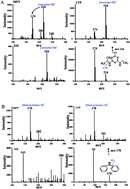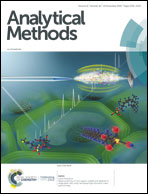Spray-inlet microwave plasma torch and low temperature plasma ionization for ambient mass spectrometry of agrochemicals†
Abstract
The unique ionization characteristics of plasma can be used in multimodal ion sources, which have expanded plasma-based ambient ionization mass spectrometry rapidly to accommodate a range of analytical applications. In this work, microwave plasma torch (MPT) and low-temperature plasma (LTP) ion sources coupled with an atmospheric-pressure interface linear ion trap time-of-flight spectrometry (LIT-TOFMS) instrument, respectively, were developed. Instead of desorption sampling, spray-inlet sampling was used for MPT- and LTP-LIT-TOFMS instruments, respectively, to analyze agrochemicals, and the results were compared to those obtained from traditional ESI-TOFMS. For the methanol solutions of eight reference samples (atrazine, chlorpyrifos, dimethoate, diphenylamine, imazalil, imidacloprid, isoprocorb, and triazophos), spray-inlet MPT and LTP exhibited similar high sensitivity with limits of detection at parts-per-billion, which was comparable to or higher than that exhibited by ESI. However, the spectra obtained from ambient mass spectrometric analysis of the pesticide residues in apple and grape peel extracts using MPT and LTP were comparable, and showed much higher ion measurements than those from the ESI spectra. In order to verify the stability of this method, eight agrochemicals were added to the apple peel extract at concentrations of 0.1 ng mL−1 for atrazine, diphenylamine, imazalil, isoprocorb, and triazophos, and 1 ng mL−1 for chlorpyrifos, dimethoate, and imidacloprid. The determined recovery rates for MPT-, LTP-, and ESI-LITMS are 61.7–83.3%, 60.0–97.5%, and 19.3–61.9%, respectively, probably due to ionization suppression caused by the matrix effect. This study shows that spray-inlet coupled MPT- and LTP-LIT-TOFMS can be effectively used for direct and rapid identification of various compounds with high sensitivity and high reproducibility in a very complex matrix, and are more suited for food quality control for contamination, fraud or authenticity checks, and even environmental quality assessment for pollutant screening, etc.



 Please wait while we load your content...
Please wait while we load your content...